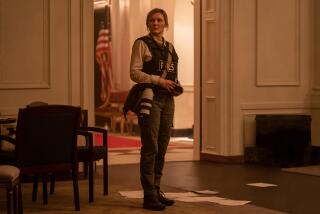Valley Weekend : OUTDOORS : Bringing Back the Bad Ol’ Days : The pull of history lures Civil War buffs, decked out in period uniforms and armed with muskets, back to the battlefields.
- Share via
Someone should be putting our mugs on postage stamps or naming holidays after us, because one weekend a month my son, Ethan, and I perform a needed public service. We shoot the traitors--just as many as we can. But they don’t actually die. Sometimes they fall over, but pretty soon, they get up again. That’s why I couldn’t get too upset when my son was killed last month. At least he was smart enough to take three steps backward and die in the shade during a particularly frantic battle.
We’re Civil War re-enactors, Yankees to be sure, and the 19th Indiana Volunteers to be specific. At Fort Tejon, on the top of the Grapevine off the Golden State Freeway, the Civil War continues in endless overtime 130 years later on every third weekend of the month. Once a real Army post, established in the 1850s, Fort Tejon has many of the original buildings intact and remains a perfectly inconvenient site for both sides.
Last month, there were three separate Sunday battles as nearly 400 blue and gray soldiers brought back the bad ol’ days of 1861-65. As Union men, we have history on our side, and we know how this ends: Union--1, Confederacy--0.
Civil War re-enacting began shortly after the war ended and is gaining in popularity all the time, especially since the Civil War centennial. So what we have here, basically, is a bunch of guys playing army outdoors, not inside slurping down their weight in brewskis and watching weekend football.
Though armed and dangerous, re-enactors are not myopic militia by any means, but Civil War buffs in expensive uniforms performing living history.
The movie “Gettysburg” from 1993 featured only about 20 actors, but more than 5,000 re-enactors performed as extras--all historically correct down to the smallest detail. There is a cottage industry supplying uniforms to re-enactors, which cost a recruit anywhere from $300 to $600. The biggest expense is the musket--an Enfield or a Springfield costs about $400.
The rifles are working replicas made in Italy. At re-enactments, black powder is used but no Minie balls and--bang--everything sounds real, looks real and is real except for all those bullets and all that blood. Also dysentery, smallpox and other diseases, which killed more Civil War soldiers than the fighting did, are mercifully absent. In addition there are no amputations, and no re-creations involving two notorious prisons, Andersonville and Elmira.
The public is invited to the battles, and in fact, the President (Lincoln, that is) was at the last Fort Tejon encampment. When he inspected our unit, I boldly advised him to rent a tape and stay away from the theater, but he didn’t appear to listen to a mere private. Also females in period attire portray nurses or Sanitation Commission workers, and little kids are drummer boys. Between battles, the public is encouraged to tour the encampments and talk to the re-enactors. Hey, it’s fun. Except for the real guys way back when.
*
The Civil War, the first war to combine modern weaponry and old-fashioned tactics, resulted in massive casualties unrivaled until World War I. The idea was to direct concentrated firepower upon the enemy until they broke and fled or died with their boots on. Thus attackers marched in ranks shoulder to shoulder. In the bad-news department, the rifled musket was accurate up to 600 yards, cannons much farther than that, so the attackers were hard to miss. Thus soldiering, as always, consisted of boredom and unrelenting routine, punctuated by moments of extreme terror.
Though all in the name of fun and history, even a re-enacted battle can be scary.
It’s hot, and everyone is red-faced and sweating as we march with our muskets on our right shoulders around an old building and onto a wide, sloping grassy field. The rebels are clearly visible formed in the line of battle a hundred yards away.
“Double quick!” shouts the sergeant, and everyone takes off at a gallop, as we serpentine down the field toward the enemy. We rapidly file to the left, re-forming into two ranks, directly in line with the rebs, who begin to open fire.
“Ready!” comes the order as we dig into our cartridge boxes and pull out one of the paper wads that looks sort of like a tamale, bite off the end and pour the black powder down the muzzle of our muskets, now half-cocked. Next we frantically reach for a cap, squeeze the brass cap onto the nipple and fully cock the hammer. At this point, the rebels fire a volley and five men fall around me. We close ranks to take their places.
“Aim!” shouts the sergeant as both ranks take aim at the gray-clad rebels, some fatter than history tells us.
“Fire!” All of our muskets go off at once as a big cloud of black powder smoke engulfs the ranks. The orders are repeated as we are expected to get off three aimed shots per minute, even as the secessionists blaze away, shouting mean things about Mr. Lincoln.
“KER-BOOM!” a double-charged rebel cannon goes off virtually in our faces as every bird instantly flies over the mountain, every spectator’s baby starts to cry and every car alarm in a 10-block radius goes off. We can feel the whoosh of the cannon’s bad breath as it whizzes by our blackened faces.
After five rounds, my Springfield musket begins to heat up; by 10 rounds, the metal parts of it are too hot to touch, yet we continue to blaze away. It’s fire at will as the men shout, laugh maniacally and drop like flies as the smoke thickens. But we will not be denied; we shoot until we nearly run out of rebels. At last, recall is blown on a bugle, and all the “dead” stand up, revived again for the next battle.
My unit, the 19th Indiana, was part of the Iron Brigade, the most famous unit in the Union Army of the Potomac. Consisting of five regiments, the 2nd, 6th and 7th Wisconsin, 19th Indiana and 24th Michigan, this was the only all-Western brigade in the eastern federal army. The brigade was decimated on the first day at Gettysburg, losing 1,212 out of 1,883 men when they held off an overwhelming number of rebels until midafternoon, allowing the rest of the Union army to arrive and occupy the high ground, where they subsequently beat off repeated rebel attacks over the next two days, and won the battle and, thus, the war.
*
Lucius Fairchild, an Iron Brigade officer who lost an arm at Gettysburg, put it in perspective at a veterans’ reunion after the war.
“You look upon us, perhaps, like a lot of braggarts who blow our own achievements, but I will tell you, young friends, back of all this there is more heartache in the bosoms of these men than you can imagine.”
So what is its allure for re-enactors 130 years later? The Civil War was to many the single most important event in American history, and as the ultimate family squabble it was particularly brutal, killing over 600,000 Americans.
In addition to the 19th, the other Union re-enactment regiments include the 2nd Vermont, the 4th U. S. and the 55th Ohio. There are also artillery and cavalry units. But unlike the real war, these days there are always more rebels. It’s the romance of the lost cause, the underdog and all that.
Over the last couple of years, local interest in the war has grown so great that just as the original fighters began at Fort Sumter and spread to encompass thousands of separate battlefields, the re-enactors, too, are fighting more often at more places than ever, far beyond the recurring battles at Fort Tejon. War may be hell, but it’s spreading.
(BEGIN TEXT OF INFOBOX / INFOGRAPHIC)
DETAILS
CIVIL WAR RE-ENACTMENT SITES
* This weekend: Although not all of these events are only Civil War functions, the blues and grays will be present and fighting at William S. Hart Park in Newhall (see details this page); at Veterans Park at the Redondo Beach Pier, (310) 374-2171, and up north at Pioneer Park in Nevada City, (916) 265-2692.
* Following this month’s Fort Tejon battles, the war resumes Sept. 22 and 23 at Irvine Regional Park in Orange County, (714) 633-8074. But the big battle of the year is slated for Oct. 14 and 15 at Kearney Park (named for Union Gen. Phil Kearney) in Fresno, (209) 441-0862, where up to 800 re-enactors are expected.
AT FORT TEJON
* Re-enactments take place the third weekend of each month through October. The next one will be Sept. 16 and 17. Re-enactors must have a Fort Tejon membership card, which costs $12, (805) 248-6692.


